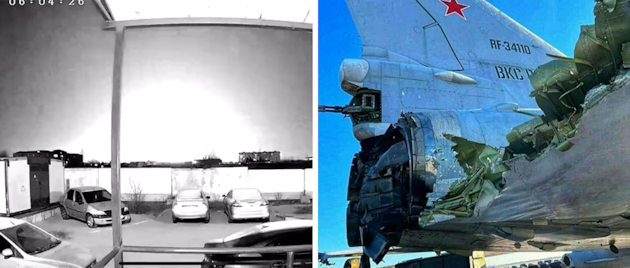Two attacks rocked the Russian military airfields in Engels and Diagilevo, hundreds of kilometers from the Ukrainian border, on Monday morning.
How could Ukraine succeed in this sensitive attack? For Army Colonel Markus Reisner, the attacks come as no surprise: “Ukraine is trying to strike where it can harm the Russians the most. She has certainly been able to gain a lot of experience in previous attacks over the past few months.”
In an interview with FOCUS online, Reisner refers to similar incidents, such as the crash of a Ukrainian Tu-141 drone in the Croatian capital Zagreb, attacks on the Russian Crimean airfield Saki and the sinking of the Russian guided missile cruiser Moskva in the Black Sea. The targets hit are starting points for Russian attacks on Ukraine’s strategic infrastructure.
According to the Russian side, the drones are said to be old Tupolev Tu-141 drones of Soviet design. Footage from a surveillance camera online shows the overflight and the explosion at the Engels base. “If you look at the recordings, there are some indicators that point to a Tu-141 drone,” analyzes Reisner. “Each type of drone makes a characteristic noise.” The old Soviet drones can fly 1,000 kilometers at low altitudes, but are actually unarmed.
“It is possible to modify this drone so that it can carry an explosive device,” Reisner is certain. “Explosives were already loaded on the Tu-141 drone that crashed in Zagreb. A good picture of the situation with the data on site, also thanks to the support of the USA, then contributed to the surprise attack.”
But how is it possible that a well-known Soviet drone flies hundreds of kilometers through Russia undetected? For Reisner, several factors play a role in the failure of the air defense: “On the one hand, the element of surprise, secondly, the approach in a very low flight pattern with several course changes and possibly a very small radar cross section.”
The Austrian considers it possible that the Ukrainians could have copied their attack tactics from the Russians: “One possibility is that the Ukraine used decoys – just like the Russians do with their drone attacks,” says Reisner. Ukraine would then have defeated the Kremlin army at its own game.
Markus Reisner is a colonel in the Austrian Armed Forces and head of the development department at the Military Academy in Wiener Neustadt. He regularly analyzes the Ukraine war for the army on YouTube.
“When it comes to attacks on the Ukrainian infrastructure, we know that Russia is using Iranian drones to distract air defenses, the cruise missiles will come later and it is hoped that then there will be no longer any anti-missiles to fight them. It may be that Ukraine flew into Russia with drones, and then on another corner the drone was used, which ended up hitting the military base.”
For him, the fact that Ukraine announced successful tests of a newly developed drone shortly before the attack is part of war propaganda. A state-owned armaments company is to develop a modern drone with a range of 1,000 kilometers by the end of the year, including armament.
“That sounds a bit like the WWII V2 rocket that was hoped to be crucial to the war. This new drone can inflict painful losses on the Russians.” But, according to Reisner, “on the other hand, the Russians have the opportunity to further escalate attacks on critical infrastructure. It is impossible to predict which side will win.”















